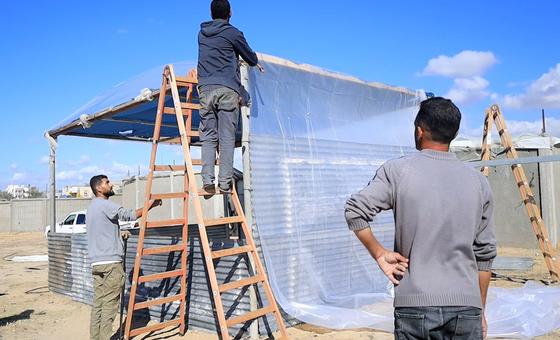“As Israeli Forces bombardment intensifies in Rafah, forced displacement continues,” said the UN agency for Palestinian refugees, UNRWA, in a post on X. “Around 110,000 people have now fled Rafah looking for safety. But nowhere is safe in the Gaza Strip and living conditions are atrocious. The only hope is an immediate ceasefire.”
Uprooted again
Latest images from Rafah provided by UNRWA showed a steady stream of people leaving the east of the city with cars, motorbikes and donkey carts laden with their belongings, in response to evacuation orders from the Israeli military.
Most of those displaced are seeking safety in Khan Younis and Deir al Balah. But these areas lack the basic services required to support civilians who need food, shelter and healthcare, aid teams maintain.
In addition to the immediate threat of ongoing military action, UN aid agencies have warned with increasing urgency since Israeli tanks rolled into Rafah border crossing on Monday that the humanitarian operation across the enclave has been crippled.
Griffiths call
“Civilians in Gaza are being starved and killed…This is Gaza today,” said the UN’s top aid official, Martin Griffiths.
In a social media post on X, the veteran aid official warned late Thursday that for days, “nothing and no-one had been allowed in or out of Gaza”.
The closure of Rafah and Kerem Shalom crossings in southern Gaza – the main entry points for critically needed aid food, water, fuel and medical supplies – “means no aid”, Mr. Griffiths continued.
“Our supplies are stuck. Our teams are stuck,” he said, a message echoed by aid teams whose assessment missions have been cancelled because of a lack of fuel.
Meanwhile, civilians have faced and repeatedly fled intense and daily bombardment and clashes “and we are prevented from helping them”, the emergency relief chief insisted.
Aid stores too dangerous to access
Meanwhile, the UN World Food Programme (WFP) reported that its main warehouse in Gaza was now out of reach.
“Our main warehouse is now inaccessible. No aid has entered from southern crossings in two days,” said WFP Palestine Country Director ad interim Matthew Hollingworth on X late Thursday.
“Thousands of people are on the move. Only one bakery is still working. Supplies of food and fuel in Gaza will only last one to three days. Without them, our operations will go into standstill.”
Hospital services threatened
From the UN Children’s Fund, UNICEF, Executive Director Catherine Russell also warned that services for premature babies risk losing power unless fuel supplies reached Gaza.
“We need fuel to move lifesaving supplies – medicine, treatments for malnutrition, tents and water pipes – as well as staff to reach children and families in need.”
Without fresh aid supplies, children and families face becoming dehydrated or will be forced to drink dangerous water, while sewage treatment centres “will overflow and spread disease further” .
Rising toll
According to the Gazan health authorities, at least 34,900 people have been killed and well over 78,500 wounded during the Israeli bombardment and ground operation in Gaza since 7 October.
Some 1,250 people were killed in Hamas-led terror attacks on southern Israel that sparked the war, with more than 250 taken hostage. Dozens are still being held.

